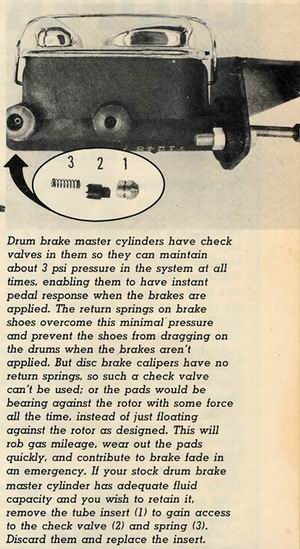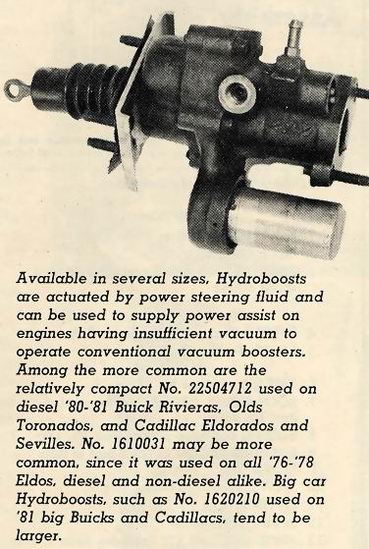74-77Camaro.com
My '75 Project
Technical
Home of the Red Headed Stepchildren of the 2nd gen Camaros!
Webmasters Note:
This article was written in 1982, so it does not include any parts after 1981. I believe most of the Cadillac parts run up through 1985. I will try to verify and repost.
High Caliper Braking
By Marlan Davis
More than ever, high performance enthusiasts want well-rounded performance cars.
Raw, straight line acceleration in isolation is no longer adequate, if
it ever was. For too long now we've ignored a vital performance characteristic
of automobiles - what it takes to stop!
In this article we will remedy this omission by covering the basics of building
an efficient high performance braking system. Four-wheel disc brakes will be
the basis of our approach because properly set up, they are far superior to
any other systems. They offer resistance to fade even after a series of repeated "panic" stops,
they perform better than drums in the wet, and their unique "feel" contributes to smooth, sure stops without the necessity of locking up the brakes.
Now before you accuse us of going all exotic on you, we'll point out that disc
brakes are widely available, both from the factory and the aftermarket - and
at an affordable price. GM has factory production systems that can be adapted
to virtually any of their cars. That's what we'll be covering here.
Before we begin, a few obligatory warnings: the correct performance of a brake
system is critical to vehicle safety. Whenever such a system is modified, it
should be well tested in an area where there is no danger to anyone, including
the driver of the test vehicle. Additionally, we recommend that all disc brake
components recommended below be used. Do not bolt on just the rear calipers
and leave it at that. While these systems can be adapted to most vehicles,
in most cases they are not a bolt-on in the traditional sense that intakes
or headers are. Parts and pieces - especially in the suspension and caliper
mounting
areas - may have to be reworked to make them fit. "Fine-tuning" will
often be required. The axles must be removed and replaced. If you think that
any of this may present difficulty to you, do not hesitate to seek advice from
a professional brake man. Good Luck!
Chevy Four-Wheel Disc Conversions
Among all the US automakers, GM has been the widest user of
rear disc brakes. The Corvette is the most noticeable
instance of a four-wheel disc GM car, but that system is not readily
adaptable for street use
on other GM cars because of the cumbersome parking
brake system and unique independent rear suspension found on Chevy's
sports car. Some '69 Z-28s
did have special 12 bolt rear ends modified to accept
the Vette rear discs, but these parts are long out of production.
However, the system found on some late GM passenger cars is fairly common,
and the parts are quite plentiful. These brakes are an adaptation of the Kelsey-Hayes-derived,
single piston front caliper, but modified to accept an integral parking brake
(really just a separate miniature drum brake), the new GM integral design features
a tensioned actuator that allows the design to double as both a conventional
disc brake and a parking brake.
The actuator is backed by a ratcheting mechanism that connects to a parking
brake lever and cable. Applying the parking brake forces the actuator against
the pads and disc (rotor); at other times it functions as a normal piston.
With this system, setting the parking brake helps the actuator compensate for
pad wear, since with the parking brake fully applied the actuator is forced
into positive contact with the pad, but when the parking brake is released,
the actuating mechanism only lets the actuator back off a set amount. If the
parking brake wasn't set regularly, the actuator would tend to stay in the
same position with the brakes off; the distance between it and the pads would
slowly
increase as the pads wore, resulting in a 'late pedal' condition.
The GM single-piston rear disc first appeared on the Cadillac '76 Eldorado,
its use being expanded to the rest of the Cadillac line in 1977. Except for
rare optional use in big Buicks from '77 on, Cadillac had an "exclusive" on
the rear discs until 1979. In that year, the Eldorado, Toronado, and Riviera
were all completely redesigned with independent rear suspensions, giving Olds
and Buick a chance to climb on the bandwagon in a big way.
Also in mid-1979, Pontiac made the basic design optional of the Firebird (that's
right, any Firebird, not just the Trans Am). That move finally brought the
system to the attention of most hot rod enthusiasts - Camaro owners wondered
why they were left out (a situation we understand will finally be rectified
when the '82's debut), and pre-'79 'Bird owners asked if they'd back fit -
not to mention all the owners of other General Motors products, from Chevelles
to GTOs, Novas to Impalas, all besieging us with the big question, "Will
it fit?"
Well, we're finally in a position to give you an answer - "Yes,
but ..." Because disc brakes have been used for so many years and on a variety of chassis,
there are a myriad of of different parts available (see chart G-1). Calipers
come in both large and small sizes that mount (depending on the year and model)
in different locations in relation to the rear axle. Two different sized discs
(rotors) are also offered. With that many permutations to choose from, and
with a little hot rodder ingenuity, the rear discs could probably be made to
fit any GM 10 or 12-bolt rearend. We personally know of three different cars
(one stock, the other two adapted) that have these brakes, and these "typical" installations are covered in an adjoining sidebar. Obviously, because of all
the differences and year-to-year changes, we can't get into specifics, but
here are a few guidelines that should set you on the right path.
| CHART G-1: General Motors Rear Disc Brake Usage | ||||||||||
| Application | CALIPER |
MOUNTING BRACKET | DISC
(ROTOR) |
|||||||
| Size* | Part No./Position | Mounting Position | Part No./Position | Size** | Bolt Pattern | Part No. | ||||
| (in relation to axle) | ||||||||||
| 76-'78 Eldorado | Big | 18004798 LH 18004799 RH | Both to rear | 3516287 both | Big | 5
on 5 |
1490626 | |||
| 77-'78 Big Cadillac and Big Buick | 18004802 both | LH back RH forward | 1610795 both | 1610797 | ||||||
| 79-'81 Big Cadillac and Big Buick | Small | 18005300 both | 1613827 both | |||||||
| 77-'78 Seville | Big | 18004800 LH 18004801 RH | LH forward RH back | 1610830 LH 1610896 RH | ||||||
| 79 Seville | small | 18005304 LH 18005305 RH | 1613944 LH 1613945 RH | |||||||
| 79-'81 Eldorado,Riviera, Toronado; 80-'81 Seville | 18005301 LH 18005302 RH | Both to rear | 1613288 both | Small | 5
on 4.75 |
1613287 | ||||
| 79 Firebird | 18005294 LH*** 18005295RH*** | LH forward RH back |
10004494 LH 10004495 RH | Big | 10005272 | |||||
| 80-'81 Firebird | 18006748 LH*** 18006749 RH*** | |||||||||
Discs (Rotors)- Full size GM cars use a 5-on-5-inch wheel bolt pattern, while F-cars (Camaro/Firebird), pre-'80s X-cars (Nova, Apollo, Ventura, Omega) and A-cars (intermediates like the Chevelle or LeMans) have a 5-on-4 3/4-inch pattern. While rotors can be re drilled, it's usually easier to start with the correct one. Most enthusiasts would be best served by the unique Firebird rotor, since it measures the large 11-inch diameter size but is drilled for the 4 3/4 inch bolt spacing pattern.
Mounting Brackets- You must use a mounting bracket that complements the rotor bring used. In other words, a mounting bracket designed to work with a small rotor won't work with a large one, and vice versa. Additionally, bracket-to-axle flange bolt patterns may differ, in which case the bracket must be re drilled. If a choice of brackets is available, use the ones that provide the greatest suspension clearance. Always use new brackets because old ones will be warped from sitting around all those years in the junkyard, exposed to the elements.
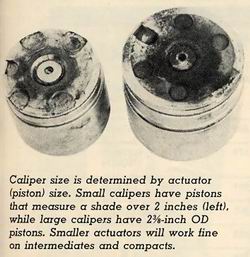 Calipers- As already noted, there are two different sizes.
The smaller ones will provide additional clearance. According to our
sources, they seem to work best on intermediates and F-cars. Naturally,
they should be matched to the appropriate bracket, as indicated in the
chart.
Calipers- As already noted, there are two different sizes.
The smaller ones will provide additional clearance. According to our
sources, they seem to work best on intermediates and F-cars. Naturally,
they should be matched to the appropriate bracket, as indicated in the
chart.
Power Boosters- More force is required to apply four-wheel disc brakes than drum brakes or disc/drums, so it is highly recommended that a dual-diaphragm vacuum/power assist be installed in place of your present diaphragm. There are approximately 20 different four-wheel disc vacuum assist units used by GM, so we can't list them all, but the Firebird unit is probably satisfactory for most intermediate and F-cars (see chart G-2). Larger cars should use a big Buick or Cad power booster, such as No. 18003815 ('78 Fleetwood) or No. 18003816 ('78 Buick Le-Sabre), since these larger units are easier to adapt to the bigger cars brake pedals. Of course, if you're buying an entire system, you may as well try to get the part specifically designed to work with the year and model of components you've purchased.
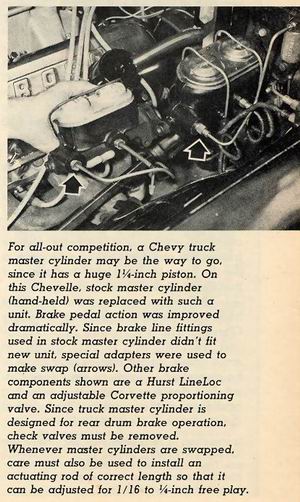 Master Cylinders- Disc brake cars require additional fluid
capacity, so in most cases the stock master cylinder is inadequate, and
should be replaced with one specifically designed for a car with four-wheels
discs. Over the years, GM has used a dozen different four-wheel disc
master cylinders (not counting the Corvette), so you have a lot to choose
from. The part number listed in chart G-2 for the '79 Trans Am was also
used on '77-'79 big Buicks and Cadillac Fleetwoods and '77-'79 Sevilles,
so it seems to be fairly universal and ought to work well for most applications.
If you're into "modernity", some of the '80-'81 four-wheel disc care use the new plastic reservoir master
cylinders, where the fluid level can be inspected without removing the
top cover. Any of the GM '76 and later passenger car four-wheel disc
master cylinders are designed to be used with power assist, and they
won't work right without it (as one of our associates found out). If
you do not desire some sort of power boost or have insufficient room
to mount such a unit, there is a Corvette dual master cylinder (current
part number No. 18001118) listed for '68-'76 models without power brakes
that has been found to work satisfactorily.
Master Cylinders- Disc brake cars require additional fluid
capacity, so in most cases the stock master cylinder is inadequate, and
should be replaced with one specifically designed for a car with four-wheels
discs. Over the years, GM has used a dozen different four-wheel disc
master cylinders (not counting the Corvette), so you have a lot to choose
from. The part number listed in chart G-2 for the '79 Trans Am was also
used on '77-'79 big Buicks and Cadillac Fleetwoods and '77-'79 Sevilles,
so it seems to be fairly universal and ought to work well for most applications.
If you're into "modernity", some of the '80-'81 four-wheel disc care use the new plastic reservoir master
cylinders, where the fluid level can be inspected without removing the
top cover. Any of the GM '76 and later passenger car four-wheel disc
master cylinders are designed to be used with power assist, and they
won't work right without it (as one of our associates found out). If
you do not desire some sort of power boost or have insufficient room
to mount such a unit, there is a Corvette dual master cylinder (current
part number No. 18001118) listed for '68-'76 models without power brakes
that has been found to work satisfactorily.
In some cases, of course, the existing master cylinder
may have enough capacity and will work. The only way
to find out is to go out to a large skid pad and try several panic stops.
Assuming adequate
capacity exists, the rear check valve must be disassembled
or rendered inactive (as shown in the photograph).
For professional racing purposes, long-distance use,
or other ultra-severe use, the various stock master cylinders may be
unable to compensate for worn pads and still give "full-competition" type
stops. In that event, you might take a leaf from the Chevy Power Book's
recommendations for road racing Corvettes. They point out that an "early Chevelle service master cylinder" has the same 1-1/8th inch diameter piston as the late Vette master cylinder,
but greater fluid capacity. If that's not enough, "a replacement master cylinder with 1 1/4-inch diameter piston can be adapted
to provide increased hydraulic fluid displacement if a progressive loss
of pedal height is encountered during an endurance event. These larger
diameter master cylinders are used on 1974 or '75 20 and 30-series Chevrolet
trucks". Try to use only top quality silicone fluid, which has a higher boiling point
and greater resistance to moisture than other brake fluids.
Proportioning Valves- The proportioning valves used in a four-wheel
disc car are completely different in design from a disc-drum type valve.
In fact, they are rightly called a "combination valve" since, unlike the conventional proportioning valve that meters only the amount
of fluid going to the rear wheels while always maintaining the same proportionate
pressure differential between the front discs and the rear drums, the
four wheel disc type valve varies both the amount of fluid and the pressure
going to the rear. As the car brakes harder and harder, this special
valve decreases the rear brake pressure to prevent the super-efficient
rear disc brakes from prematurely locking up the rear end.
In most cases, the four-wheel disc brake metering
valve intended for the year, make, and model brakes you are using
should work provided equal size front
and rear tires are used. If tires are unequal in size, or you have a non-production
combination (such as an early Chevelle with old-style four-piston front calipers,
to mention an extreme example), you may have to once again dip into the Vettes
parts book and order a No. 3878944 adjustable metering valve that enables
the brake pressure to be varied from approximately 250 to 650 psi.
Parking Brake - There's always a chance that the stock cables will bolt up, but don't make book on it! Since discs were installed on a variety of cars, chances are fairly good that you can find cables that'll fit: try cables from a big car if you have a big car, a Seville if you have an intermediate, and the Trans Am if you have an F-car. '77-'78 Seville parking brake cables have been known to work on an early Chevelle with a narrowed 12-bolt rear end (1611440, left; 1611441, right). In some cases, longer cables may have to be shortened to work, or even fabricated. But don't run without a parking brake; not only is it against the law, but the brakes won't self adjust.
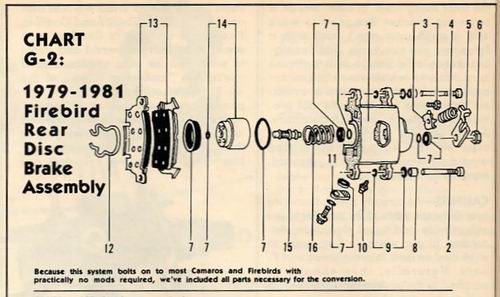
| Illustration Key | Description | GM GRP. No. | Model | Part No. | Amt Reqd. |
| 1 | HOUSING, Rear Disc Brake Caliper* | Not Stocked Separately | |||
| 2 | BOLT, Caliper | 4.665 | 79-81 | 5474509 | 4 |
| 3 | BRACKET, with Bolt Kit (mounts parking brake cable) | 4.665 | 79-80 | 18005290 | 1/LH |
| 18005291 | 1/RH | ||||
| 81 | 18006631 | 1/LH | |||
| 18006632 | 1/RH | ||||
| 4 | SPRING, Parking Brake Lever Return | 5.151 | 79-81 | 18003460 | 2 |
| 5 | LEVER, Parking Brake Shoe | 5.149 | 79-81 | 18003456 | 1/LH |
| 18004402 | 1/RH | ||||
| 6 | NUT (part of item No. 15) | Not Stocked Separately | |||
| 7 | BOOT & SEAL PACKAGE (also part of item No. 13) | 4.665 | 79-81 | 18005442 | 2 |
| 8 | SLEEVE, Bolt (also part of item No. 13 | 4.665 | 79-81 | 5474406 | 4 |
| 9 | BUSHING PACKAGE (also part of item No. 13) | 4.665 | 79-81 | 18001233 | 4 |
| 10 | VALVE, Bleeder (10mm x 1.5) | 4.666 | 79-81 | 18004702 | 2 |
| 11 | FITTING, Inlet | 4.686 | 79-81 | 18004722 | 2 |
| 12 | SPRING KIT, shoe | 4.669 | 79-81 | 18004026 | 2 |
| 13 | SHOE & LINING KIT (includes items 7, 8, 9) | 5.017 | 79-81 | 18005292 | 1 |
| 14 | ACTUATOR ASSEMBLY, Piston | 4.665 | 79 | 18004404 | 1/LH |
| 18004405 | 1/RH | ||||
| 80-81 | 18006691 | 1/LH | |||
| 18006692 | 1/RH | ||||
| 15 | SCREW ASSEMBLY, Actuator, with Locknut | 4.665 | 79-81 | 18001231 | 1/LH |
| 18001232 | 1/RH | ||||
| 16 | SPRING | Not Stocked Separately | |||
ADDITIONAL PARTS REQUIRED
(Not shown in illustration) |
|||||
| PEDAL, Brake (more leverage) | 4.625 | ||||
| With Auto Trans | 79-81 | 10005206 | 1 | ||
| With manual trans | 79-81 | 10007527 | 1 | ||
| CYLINDER, Brake Master | 4.650 | ||||
| All | 79-80 | 18005285 | 1 | ||
| Turbocharged motor | 81 | 18008061 | 1 | ||
| Non-turbo motor | 81 | 18008060 | 1 | ||
| VALVE, Rear brake Pressure Regulator | 4.690 | 79-81 | 1257187 | 1 | |
| CABLE, Parking Brake | 4.779 | 79-81 | 10004675 | 1/RH | |
| 10004676 | 1/LH | ||||
| CYLINDER, Power Brake Vacuum Assist | 4.901 | 79-81 | 18004365 | 1 | |
| PLATE, Rear Brake Flange Mounting | 5.001 | (See chart G-1) | |||
| SHAFT, Rear axle** | 5.420 | 79-81 | 1263988 | 2 | |
| ROTOR, Rear Wheel Brake | 5.809 | (See chart G-1) | 2 | ||
| BOLT, Wheel to Hub (wheel stud)*** | 5.812 | 9590271 | 10 | ||
